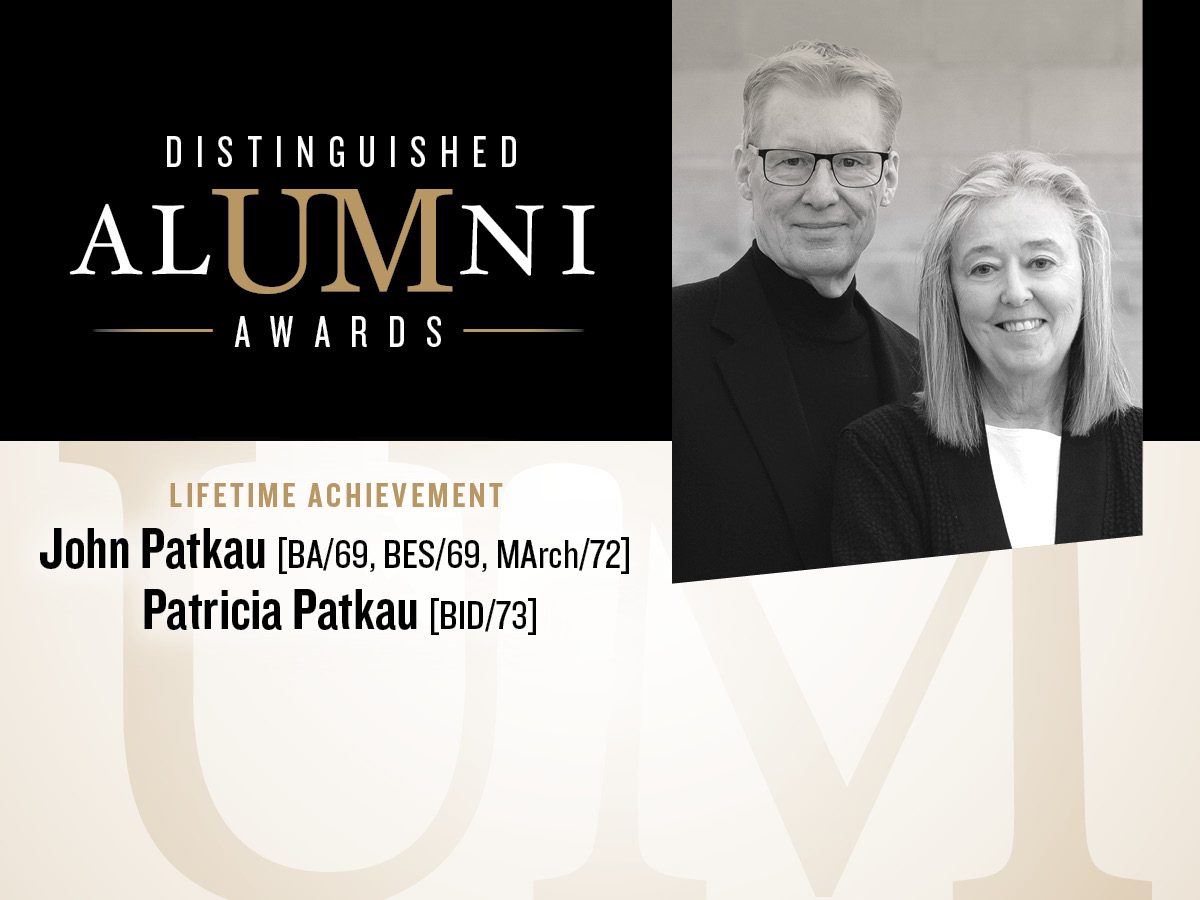
The 2017 Distinguished Alumni Award Recipients for Lifetime Achievement are John and Patricia Patkau
The recipients of the 2017 University of Manitoba Distinguished Alumni Awards have been selected, representing graduates who are outstanding in their professional and personal lives. These honourees encompass a wide range of achievement, innovation and community service and inspire fellow alumni, current students and the community.
Help us celebrate John and Patricia’s achievements at this year’s Distinguished Alumni Awards Celebration of Excellence. Get your tickets here.
Lifetime Achievement
From the outset, John [BA/69, BES/69,MArch/72] and Patricia Patkau [BID/73] were determined to pursue projects that reflect and support society. Since establishing Patkau Architects in 1978 they have brought their juxtaposition of culture, connection and community to high-profile and highly meaningful projects across Canada, the United States, Asia, and the Middle East—from schools, colleges and universities to galleries, community centres and bridges.
In Winnipeg, we enjoy their deft touch at the beautifully appointed Millennium Library, and our very own innovative ARTLab and Taché Hall redevelopment.
Patricia is Professor Emerita at the University of British Columbia and has been a visiting professor at a number of universities in the United States; John has served as a visiting professor at Harvard and Yale. They were made members of the Order of Canada in 2005.
In Their Own Words
John and Patricia Patkau had a chance to tell us about their time at the U of M, how architecture has changed over the years and some of their other thoughts, memories and musings.
Patricia: Going to the U of M, it was very outward looking. You were encouraged to look at the rest of the world. I mean, if you’re at a school that’s at the centre of everything, you don’t have to look outward.
John: The [UofM] architecture program was possibly the best in Canada at that time. (Dean Russell) brought in great faculty, he built an enormous library, and it was really incredible. We didn’t know any of that at the time; we just got lucky.
Patricia: In University, I started in physics and math, but I parked besides the Architecture building. I would walk through it, and I always thought, “Gee, that looks fun.”
John: Architecture is a highly volatile profession. It’s very dependent on economy. Grads are thrown into the world into very different circumstances, depending on economy. It’s not then versus now, it’s the cycles (of the economy).
Patricia: The year before we met, we were both working in Vancouver for the summer. John took a trip down the coast to San Diego to look at buildings; my friends and I took the bus down the coast, doing the same trip. We didn’t meet, though surely he drove past us.
John: We’ve been married for 43 years, and our relationship is stronger now than ever. We’ve negotiated our way through.
Patricia: From the beginning, we decided projects that were deeply committed to the places they were in was important. Not just the physical place, but the social, political, the economic, the cultural. The complexity of that specific place is what’s important.
John: There’s been a complete transformation of how we work. Pat and I still have drawing boards, and work at them, but everyone else works fully on computers.
John: Working with digital media has become a central skill which wasn’t the case when we began. It creates a different way of thinking. It’s very enabling. We can do things that weren’t possible 25 years ago.
Patricia: Digital media has allowed young architects to be entrepreneurial. They’re much more peripatetic; they travel where they find the opportunity.
John: One reason I took up teaching after she retired was the empowerment she gained from being a teacher. Teaching’s always been a very powerful complement to practice in our profession.
John: We still run a relatively small firm so we can do the things we want. We don’t want to be managers in a big firm, we want to be design principals.
John: We’re not refining and honing, we’re radically rethinking everything, based on a lifetime of experience. I guess we’re contrarians that way.
John: We don’t have a goal, but day to day, we want to do interesting things.
Patricia: Even though we don’t know what they will be, when they present themselves we go for it.
Patricia: We have the freedom to play, though others would call it research.
Patricia: When the Millennium Library opened, I remember a librarian said to us, “I’m so happy I could cry.”
John: It’s the nature of our discipline to embody community. Our projects, and buildings, are a reflection and a support of community.
Patricia: When given a program and a brief, we try to restructure it. Are there other options we could create to extend the possibilities of how people will use this?
Patricia: Public buildings represent the richest area of architecture for us to work in, because of community and culture. We find them richest and we believe, long-term, they’re the most meaningful, the ones that shape a society over time.
Patricia: Houses are only interesting for us if they’re explorations of new ground. You need clients that are confident and ready to explore.
John: We try to be proactive in our design. We try to invent the spaces that support the activities that we think are important. Sometimes those aren’t originally on the agenda.
John: To be meaningful, sustainability has to be there at inception. You don’t tack it on at the end.
John: The whole question of sustainability is a transformation that has been accomplished. Leading practitioners everywhere are committed to sustainability. It’s not even a discussion anymore.
Patricia: The Order of Canada is about Canadian culture, not just our profession, so that’s meaningful.
John: Japan is a leading area in our profession, both historic and modern. The work that’s being done there is innovative, on the edge. The culture supports risk and experimentation. We go to see what can be done when people are given the opportunity to innovate.
Related Stories
The 2017 Distinguished Alumni Award Recipient for Professional Achievement is Reva Stone
The 2017 Distinguished Alumni Award Recipient for Community Service is Lesley Sacouman
The 2017 Distinguished Alumni Award recipient for Outstanding Young Alumni is Desiree Scott







I was very impressed with the Patkaus’ statements and got a kickout of their still using drawing boards. Since I graduated in 1953 there have been so many changes with the advent of computers and technology I have wistfully thought I wish I had learned that at Manitoba, but it wasn’t available then!